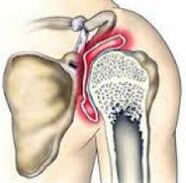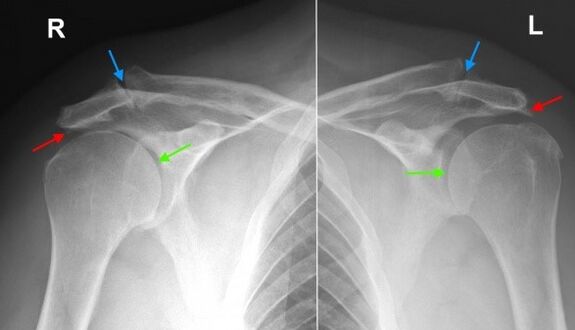Shoulder arthropathyIs chronic A disease in which articular cartilage tissue is destroyed and thinned, soft tissues undergo pathological changes, and bone hyperplasia is formed in joints. It manifests as pain and crunch in the affected area. In the later stages, the range of motion is reduced. The pathology is chronic and progresses gradually. Take into account the clinical pictures and radiological signs for diagnosis. Treatment is usually conservative: physical therapy, anti-inflammatory drugs, chondroprotectants, exercise therapy. When the joint is destroyed, arthroplasty is performed.
A disease in which articular cartilage tissue is destroyed and thinned, soft tissues undergo pathological changes, and bone hyperplasia is formed in joints. It manifests as pain and crunch in the affected area. In the later stages, the range of motion is reduced. The pathology is chronic and progresses gradually. Take into account the clinical pictures and radiological signs for diagnosis. Treatment is usually conservative: physical therapy, anti-inflammatory drugs, chondroprotectants, exercise therapy. When the joint is destroyed, arthroplasty is performed.
General information
Shoulder arthropathy is a chronic disease in which the cartilage and other tissues of the joint are gradually destroyed due to the process of degenerative dystrophy. Arthropathy usually affects people 45 years and older, but in some cases (after injury, inflammation), the disease may develop at a younger age. Pathology also occurs frequently in women and men, and is more common in athletes and people engaged in heavy physical labor.
the reason
The starting point of changes in the shoulder joint joints can be the normal aging process of the tissue, or the damage or destruction of the cartilage structure caused by mechanical influences and various pathological processes. Primary arthropathy is usually detected in the elderly, and secondary (developing in the context of other diseases) can occur at any age. The main reasons for consideration are:
- Developmental defects.Pathology can be detected by abnormal dysplasia of the humeral head or glenoid, shoulder joint capsule, and other upper limbs.
- trauma.Traumatic arthropathy most often occurs after intra-articular fractures. One possible cause of the disease may be shoulder dislocation, especially the usual shoulder dislocation. Rarely, severe bruises can cause injury.
- Inflammatory process.The disease can be diagnosed as long-term frozen shoulder, with non-specific septic arthritis and specific arthritis in the past (with some diseases such as tuberculosis, syphilis).
Risk factors
Arthropathy is a multi-cause disease. There are many factors that increase the likelihood of this pathology:
- Genetic predisposition.Many close relatives of patients also suffer from arthropathy, including arthropathy of other parts (knee joint disease, hip joint disease, ankle joint disease).
- Overworked joints.It can occur in volleyball players, tennis players, basketball players, sports equipment throwers, and occupations (hammers, loaders) that continue to bear heavy loads on their hands.
- Other pathologies.Arthropathy is more commonly detected in patients with autoimmune (rheumatoid arthritis), certain endocrine diseases and metabolic disorders, systemic connective tissue dysfunction, and joint hypermobility.
With age, the possibility of suffering from this disease will increase dramatically. Frequent hypothermia and adverse environmental conditions will have certain negative effects.
Onset
The main reason for the development of shoulder joint arthropathy is the change of articular cartilage structure. Cartilage loses smoothness and elasticity, and the sliding of the articular surface becomes difficult during exercise. Micro-trauma occurred, leading to further deterioration of cartilage tissue condition. Small pieces of cartilage break away from the surface to form a freely placed joint body, which can also damage the inner surface of the joint.
Over time, the capsule and synovium thicken, and fibrotic areas appear in them. Due to the thinning and reduced elasticity, the cartilage ceases to provide the necessary shock absorption, and therefore, the load on the underlying bones increases. The bones deform and grow along the edges. The normal configuration of the joint is disrupted and movement is restricted.
classification
In traumatology and orthopedics, three-stage systemization is usually used to reflect the pathological changes and the severity of symptoms of shoulder joint arthropathy. This method allows you to choose the best medical strategy while taking into account the severity of the process. Distinguish the following stages:
- first of all-There is no obvious change in cartilage tissue. The composition of synovial fluid changes and the nutrition of cartilage is impaired. Cartilage cannot withstand pressure, so joint pain (arthralgia) occurs from time to time.
- second-The cartilage tissue begins to thin, the structure changes, the surface loses smoothness, and cysts and calcified areas appear deep in the cartilage. The lower bone is slightly deformed, and bone growth appears along the edge of the joint platform. The pain becomes permanent.
- third-The cartilage structure is significantly thinned and destroyed, destroying a large area. The joint platform is deformed. Shows limited range of motion, weakness of ligament devices, and muscle atrophy around joints.
symptom
In the early stages, patients with arthropathy worry about discomfort or slight pain in the shoulder joint during exertion and certain body positions. There may be crunching noises during exercise. The joints had no external changes and no edema. Then the intensity of the pain increases, and the joint pain becomes habitual and persistent, not only during exercise, but also during rest, including at night. The salient features of pain syndrome:
- Many patients notice the dependence of the pain syndrome on weather conditions.
- With the pain, with the passage of time, there will be severe soreness during physical exertion.
- The pain may only occur in the shoulder joint, radiate to the elbow joint, or spread to the entire arm. There may be back and neck pain on the affected side.
After some time, the patient began to notice significant morning stiffness in the joints. The range of motion is reduced. After exercise or hypothermia, the soft tissues may swell slightly. With the development of arthropathy, movement is becoming more and more restricted, contractures develop, and limb function is severely impaired.
diagnosis
The diagnosis is made by the plastic surgeon based on the characteristic clinical and radiological signs of shoulder arthropathy. If you suspect secondary joint disease, please consult a surgeon or endocrinologist. At first, there is no change in the joints, but sometimes they deform or expand. On palpation, the pain is determined. The restriction of movement can be detected. In order to confirm the joint disease, the following operations are recommended:
- Radiography of the shoulder joint.Discovery of dystrophic changes and marginal bone growth (osteophytes), in the later stages of joint space narrowing, deformation, and changes in the underlying bone structure are determined. The joint space can be wedge-shaped, and changes in bone sclerosis and cystic formation can be seen in the bone.
- Tomography research.In case of doubt, especially in the initial stages of the disease, CT of the shoulder joint is performed to obtain additional data on the condition of the bones and cartilage. If the condition of the soft tissue needs to be assessed, magnetic resonance imaging is performed.
Differential diagnosis
The differential diagnosis of arthropathy is made by gout, psoriasis, rheumatoid and reactive arthritis, and pyrophosphate arthropathy. For arthritis, blood tests show signs of inflammation; the changes on the X-ray film are not very obvious, there are no osteophytes, and no signs of deformation of the articular surface.
In psoriatic arthritis, in addition to joint manifestations, rashes are often found. In rheumatoid arthritis, the positive rheumatoid factor is determined. For pyrophosphate arthropathy and gouty arthritis, biochemical blood tests show corresponding changes (increased uric acid levels, etc. ).

Shoulder arthropathy treatment
The patient is under the supervision of a plastic surgeon. It is necessary to limit the load on the arm, excluding sudden movements, lifting weights and carrying heavy objects for a long time. At the same time, it should be remembered that inaction can also have a negative impact on diseased joints. In order to keep the muscles in a normal state and restore the shoulder joints, you need to regularly perform comprehensive exercise therapy recommended by your doctor.
Conservative treatment
One of the most urgent tasks of joint disease is to fight pain. In order to eliminate pain and reduce inflammation, the following are prescribed:
- General acting drugs.NSAIDs are prescribed in tablet form during exacerbations. If used uncontrollably, they can stimulate the stomach wall and have a negative impact on the liver and cartilage metabolism. Therefore, they can only be taken as directed by the doctor.
- Local remedies.NSAIDs are usually used in the form of gels and ointments. If symptoms appear or worsen, you can self-administer. It is less common that topical hormone preparations are required and should be used in accordance with the doctor's recommendation.
- Hormones for intra-articular administration.In the case of severe pain syndrome that cannot be eliminated by other methods, intra-articular administration (triamcinolone, hydrocortisone, etc. ) is given. The lockdown does not exceed 4 times a year.
To restore and strengthen cartilage in the first and second stages of arthropathy, drugs from the chondroprotectant group-drugs containing hyaluronic acid, chondroitin sulfate, and glucosamine are used. The treatment course is longer (6 months to more than 1 year), and the effect is significant for more than 3 months.
Physiotherapy treatment
For shoulder joint arthritis, massage, physiotherapy exercises and physiotherapy techniques are actively used. During remission, the patient was referred for hydrotherapy treatment. Application:
- Mud therapy and paraffin wax;
- Medicated bath;
- Magnetic therapy and infrared laser therapy;
- Ultrasound.
surgery
In the third stage of the disease, joint replacement is performed with the significant destruction of cartilage, restricted mobility, and disability. Taking into account the patient’s age, activity level, and the presence of serious chronic diseases, surgery will be referred. The use of modern ceramics, plastics and metal prostheses allows you to fully restore the function of your joints. The service life of the prosthesis is more than 15 years.
forecast
Arthropathy is a long-term, progressive disease. It cannot be completely cured, but it can significantly slow down the development of joint pathological changes, maintain working ability and a high-quality life. In order to achieve maximum results, patients must take their condition seriously and be willing to follow the doctor’s advice, even during remission.
prevention
Preventive measures include reducing family injuries, paying attention to work safety, and eliminating excessive load on the shoulder joints when performing professional duties and sports. It is necessary to promptly diagnose and treat pathologies that can cause changes in arthritis.



































